Gokyo Ri
The wonderful mountain vistas, Gokyo lakes, mountain valleys and settlements, locals’ lifestyle and tradition, and the distinctive flora and fauna of the Sagarmatha national park makes the trek to Gokyo Ri so exceptional.
The wonderful mountain vistas, Gokyo lakes, mountain valleys and settlements, locals’ lifestyle and tradition, and the distinctive flora and fauna of the Sagarmatha national park makes the trek to Gokyo Ri so exceptional.
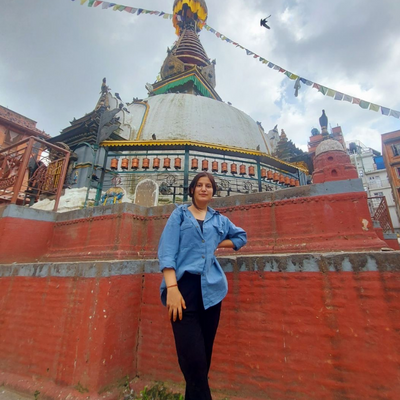
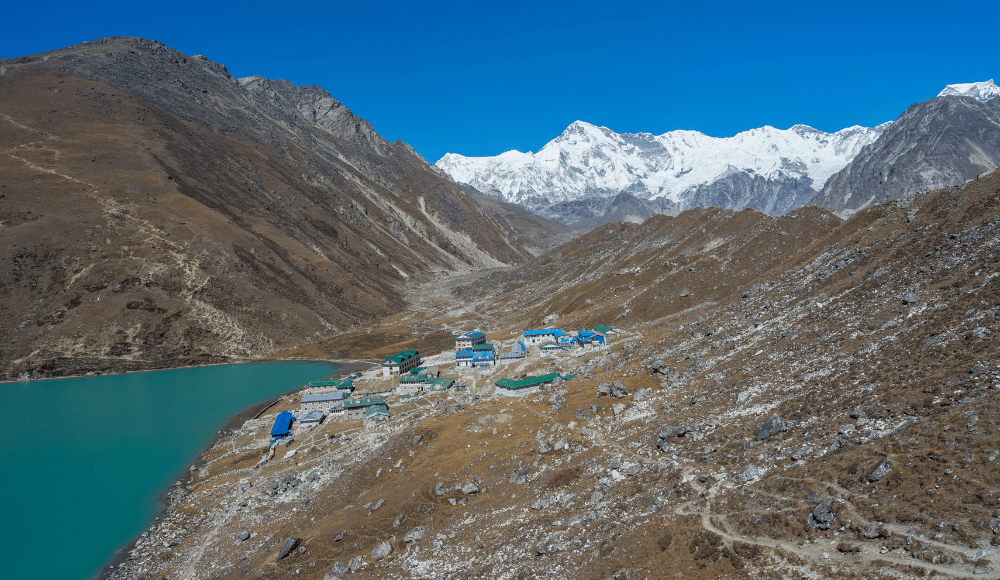
A sublime beauty in the highland of Everest is the exhilarating Gokyo Ri. It is the only viewpoint in the Khumbu region from which the four tallest peaks of the world Everest, Cho Oyu, Lhotse, and Makalu are unobstructedly visible. Trekking to Gokyo Ri is the best substitute for the commercial and overhyped traditional Everest base camp trek. Especially the sunrise and sunset from this glam zone vest you with the surreal venture of pure utopia.
Gokyo Ri provides a top-notch experience of trekking through the Himalayas. The amazing blend of the peaceful, tranquil mountain ambience and the divine-looking serene lakes pokes Gokyo Ri as a mystic paradise on planet earth. Getting to this wonderland is the lifelong achievement one can ever have.
The trek to Gokyo Ri takes you across the remote mountain villages, varied plains, terrains and the diverse assortment of flora and fauna in the Khumbu region. In comparison to those busy crowded trails of the Khumbu region, this Gokyo Ri shines out as the unique venue with its secluded, and untrodden trails.
A jewel of the Khumbu region, Gokyo Ri is a go-to destination for those who want to experience a touch of culture, with a boastful nature. The beautifully settled small hamlet just below the Gokyo Ri, known as the Gokyo village is another astonishment to your yearning soul. This little remote lifestyle demonstrates the countryside vibes and their daily practices. So, you could get a moment to relish the sheer beauty of the mountain paradise. Also the largest glacier in Nepal, moreover in the entire Himalayas, Ngozumpa glacier is another lime stealer of the spellbinding Gokyo Ri.
Whenever the name Gokyo Ri appears, all the enthusiasts feed this one single query. What makes Gokyo Ri stand out from the infamous Everest base camp? To your surprise, this bewitching Gokyo Ri is worth more than the Everest base camp and all other Shangri-la in the Khumbu region. Why so? To know this exactly, you need to go through the following details of this article. Stay tuned to know more about the exquisite Gokyo Ri!
|
Name |
Gokyo Ri |
|
Elevation |
5357 m |
|
Adventure Type |
Trekking |
|
Trek Level |
Moderate to Strenuous |
|
Permits Required |
|
|
Best Time to Visit |
Spring (March, April and May) Autumn (September, October and November) |
|
Major Attractions |
|
|
Accommodation |
Lodges and Tea Houses |
|
Extensions |
Everest Base Camp Trek |
Get in touch with our experts right away and finalize an experience!
About UsGokyo Ri, a land of pure bliss, is located on the west of Ngozumpa glacier. It is an attribute of the Sagarmatha national park, which is the national park at the highest elevation in Nepal. It lies in province no 1, the district of Solukhumbu on the lap of the roof of the world, Mount Everest. Basically, Gokyo Ri is popular as the trekking point granting an absolutely perplexing view of the wonders prominent in the Khumbu region.
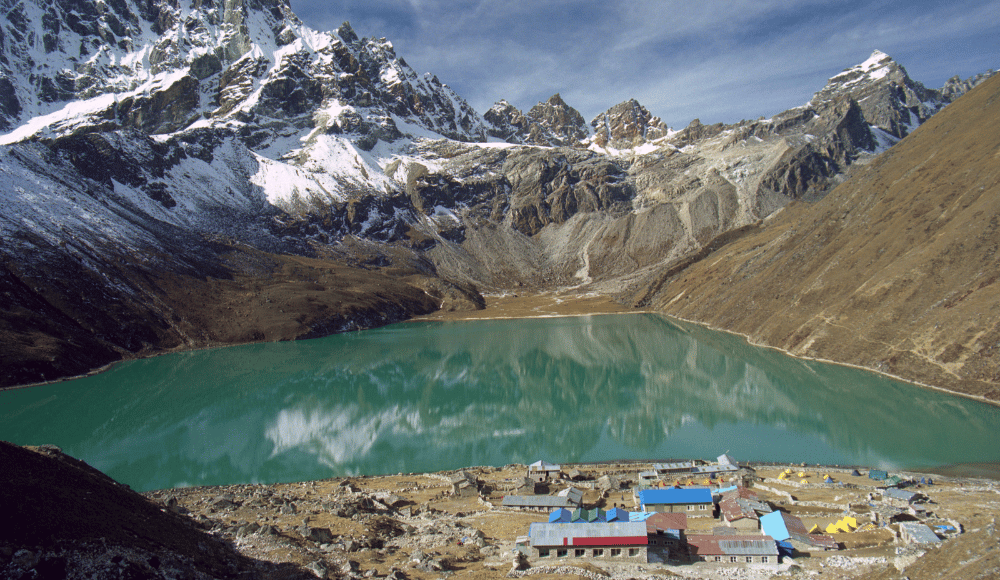
Nowadays, the crowd marching to Gokyo Ri is increasing day by day. It's because the trails are quiet, and the vistas are great with jaw-dropping mountain backdrops. Also, the Gokyo lakes, the freshwater lake system at the highest altitude, are spotted on the trails to Gokyo Ri. Apart from this, the trail leading to Gokyo itself is another highlighting part of the Gokyo Ri.
One can have the feeling of being on another planet as you gaze at what's in front of you from the top of the Gokyo Ri. It feels like mountains ranging above the clouds are keeping an eye on you, appreciating your little effort for victory and accompanying you will be the chill crisp air of the mountain region.
Related read: Where is mount Everest located?
It's obvious the popularity lies behind the attractions and this same goes for the Gokyo Ri too. Gokyo Ri is in the thoughts of many because it has got some alluring features aiding its beauty. Some of them are mentioned below with a brief description:
The major attraction of Gokyo Ri is the marvellous mountain views. Several peaks such as Everest, Lhotse, Cho Oyu, Makalu, Thamserku, Cholatse, Kang Tega and many more are spotted from the top of Gokyo Ri. Also, Cho Oyu looks fabulous from here. It is also said that the views you get from here surpass those from the Kalapathar. So, Gokyo Ri is the vantage point of the Everest region garnishing the finest views of the eight-thousanders.
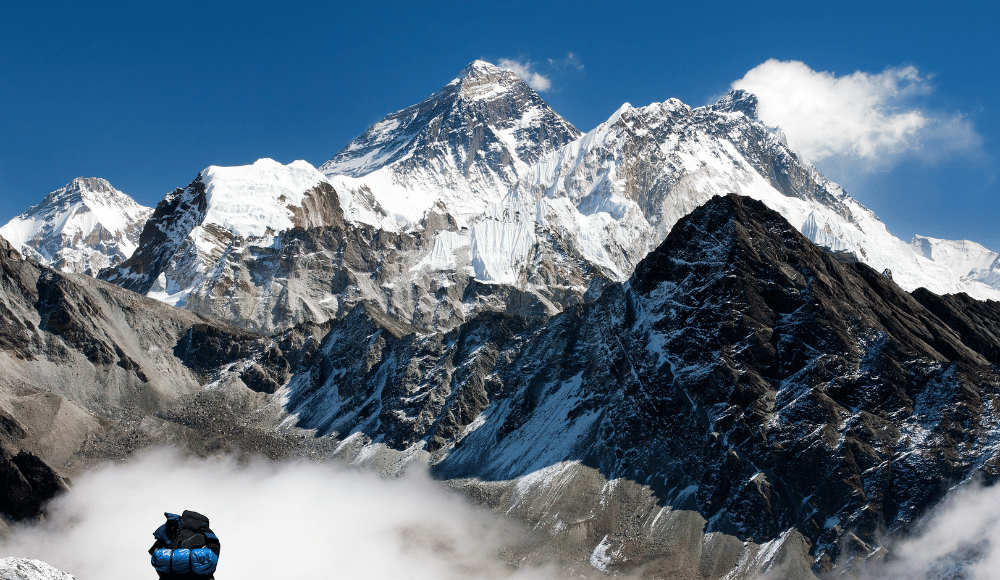
Gokyo Lakes are oligotrophic lakes within an elevation of 4000-5000m residing in the Sagarmatha national park. The association of six main lakes come under the name Gokyo lakes, with lake Thonak being the largest and Gokyo Cho (Dudh Pokhari) being the major one. Usually, the first five lakes are visited by the trekkers while the sixth one is neglected as it is just a deep black lake at a higher elevation. Also, the other 19 lakes and the wetlands are adjoined to the Gokyo lakes association under the convention of Ramsar site in the year 2007. Moreover, The Gokyo lakes trek is another popular trek in the Khumbu region. During the trek to Gokyo Ri, you can observe three lakes of the Gokyo system, and the third lake, Gokyo Cho, looks phenomenal. It lies on the eastern side of Gokyo village. It is the blue turquoise alpine lake which freezes during the winter months.
A small mountain hamlet just below the Gokyo Ri alongside the Gokyo Cho is the Gokyo village. The name Gokyo is placed after the viewpoint of Gokyo Ri. This Gokyo Village is originally a flat pasture used for grazing cattle in the old times. Later the locals shift here along with their cattle building small heaps so that it would be easy to handle their households along with the cattle grazing. Talking about the current settlements, this village is the only available accommodation in this elevation for the Gokyo Ri and Gokyo lakes trek.
Gokyo village is also known as the village with the highest human settlement at an elevation of 4750 m. There are few houses in this village, all the traditional ones with rooftops of green and red. All the residents over here dress up in the traditional Sherpa attire portraying the Sherpa culture and tradition which is quite fascinating. Only the very basic amenities are available in this village making it an authentic Sherpa village on the mountain edge. This village boasts an enthralling decor involving the straddling peaks and the pristine Gokyo lakes. Completing the picture will be the local's lifestyle.
Ngozumpa glacier is the glacier below the Cho Oyu, the sixth highest peak in the world, spreading up to 36 km. This is the longest glacier in Nepal, in the entire Himalayas and the full picture of this glacier is spotted from the top of Gokyo Ri. According to the research conducted by the Icimod, the ice of this glacier is found to be 5 km thick. This glacier along with the serpent-like Spillway looks enormous from the Gokyo ridge. Because of rapid global warming, there is a constant threat lingering over the nearby Sherpa settlements of the possible havoc that can take place by the thrashing of this Himalayan giant, the Ngozumpa glacier. So, this glacier is taken not only as a beauty but also as the worst possible natural outburst.
Gokyo Ri feeds the best mountain vistas and scenery but there is no motor connection to this viewpoint. So, the only option one can ever have to get up here will be trekking. This trek to Gokyo Ri is wildly renowned among the crowd and every year hundreds of trekkers trek into this region. The trekking starts and ends at Lukla. During the trek, you will pass through various suspension bridges, plunging waterfalls, river shores, woodlands, floras, faunas, and several mountain settlements.
Gokyo Ri trekking is challenging yet the worthiest trek. The scenic flight to Lukla is the beginning of the wonderful adventure which ends with the jaw-dropping vistas of Everest and the long Ngozumpa glacier. Also, three of the Gokyo lakes come into sight during this trek, and the third lake, the major one, lake Dudh Koshi is much more spectacular and is just in the front yard of Gokyo village.
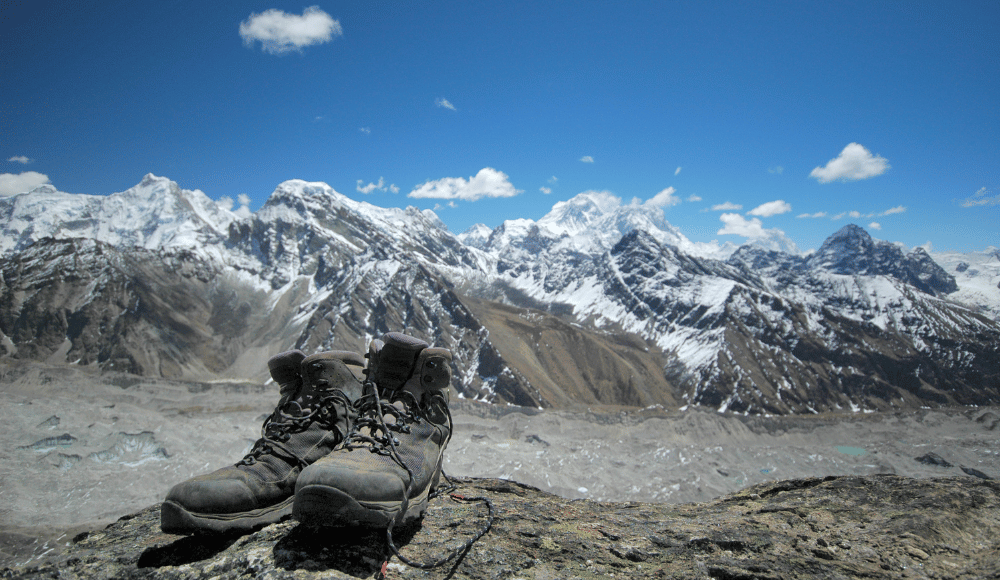
Many trekkers rest on the lake shore for some time appreciating the hidden jewel of the Gokyo trek. The lake looks ethereal with the shining clear mountain water in the shade of deep blue-green. You can see ducks playing in the lake if you get there during the autumn period. Not only of the beauty prospect but this lake is also appreciated for religious significance as it is considered sacred. So, not only for the mountain view, some treks in this region for taking a holy bath in the pious Dudh Kosi lake. A huge crowd forms during the festive time of Janai Purnima in this lake.
There are various trails up to the Gokyo Ri. The easiest and the shortest go through Lukla, Phakding, Namche, Dole, Machhermo, and finally Gokyo. You need to compulsorily add two days as the acclimatisation during this trek. An outline itinerary of this Gokyo Ri trek is mentioned below. You can go through that for your reference. Additionally to this, you can extend the Gokyo Ri trek up to the Everest base camp and the Gokyo lakes trek. Also, those who participate in the Everest three passes trek pass through the Gokyo valley.
To get to Gokyo Ri, first, you need to reach Kathmandu Nepal. After that, you can have the options of what to choose. No matter how long the vacation is there is always a rush during the visit. So, driving to the Gokyo Ri is not practically feasible as it may take longer days which does not favour many. Hence two options would be practical and applicable to all for the Gokyo Ri visit. One is the flight to Lukla and the onward trek and the other is the helicopter tour to Gokyo. A short description of these two is cited below:
If you go with the flight, you need to take a flight to Lukla from Tribhuvan international airport, Kathmandu. It takes around 45 minutes for the flight to reach Lukla. Also, keep it a note that during the peak season there is the highest possibility of your flight getting diverted to Ramechhap airport because of the heavy traffic congestion in Lukla airport. After the Ramechaap, then only the flight will be redirected to Lukla. After Lukla, you have to trek onward up to the Gokyo Ri. The most common trail to Gokyo Ri is the Lukla, Phakding, Namche, Dole, Machhermo, Gokyo and the summit of Gokyo Ri. It may take around 12 to 14 days for the complete visit of Gokyo Ri from Kathmandu.
It is best for those who want to escape the long strenuous trek of the Khumbu region as it is a luxury ride to the Gokyo Ri. If you go with this, you will be taken by a chartered helicopter to the Gokyo valley. It will only take 3 to 4 individuals on a single flight. Firstly, you will fly to Lukla from Tribhuvan international airport. It may take longer than the regular flight for the helicopter to reach Lukla, approximately, an hour. In Lukla refuelling is done, and after this, you will be taken to the Gokyo valley. It may take around 25 to 30 minutes to reach Gokyo valley from Lukla. During the flight, you will get to observe the best aerial view of the Khumbu region, which indeed includes the Namche bazaar, snow-capped peaks and the mesmerising Gokyo lakes. After landing in Gokyo valley, you can join the trek of Gokyo Ri, which is just a trek of about 2 to 3 hours. This helicopter tour to Gokyo Ri comes a bit pricey in comparison to the regular flights.
|
Day 01 |
Flight to Lukla, Trek to Phakding. |
|
Day 02 |
Trek to Namche Bazaar |
|
Day 03 |
Acclimatisation day in Namche |
|
Day 04 |
Trek to Dole |
|
Day 05 |
Trek to Machhermo |
|
Day 06 |
Trek to Gokyo |
|
Day 07 |
Ascend to Gokyo Ri, Explore around the Gokyo Lake. |
|
Day 08 |
Trek to Lunde via Renjo La pass |
|
Day 09 |
Trek to Namche Bazar |
|
Day 10 |
Trek to Lukla |
|
Day 11 |
Return Flight to Kathmandu |
Autumn and Spring are the most ideal time for the Gokyo Ri visit. In Nepal, Autumn falls under the months of September, October and November, while spring rises in March, April, and May. So, the best time to visit Gokyo Ri is September, October, November, March, April and May.
In Autumn, the visibility is nice with bright clear days without a hint of the dark clouds forming on the mountain peaks. Because of the clear atmosphere, all the attractions and the glories in the Khumbu region are equally visible granting a fantastic view. October months are the best for the Gokyo Ri trek with the incredible mountain vistas. The alpine lakes shimmer greatly during this time sparkling with the water bubbles on the surface. Since it's the best time, there may be some crowd lurking behind you during this time.
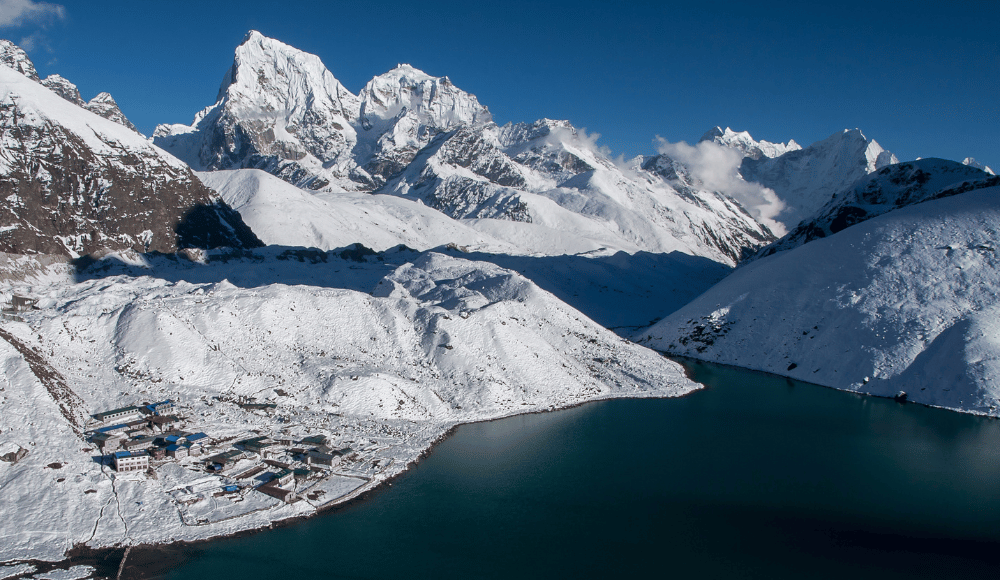
In Spring, the temperature is perfect. Even in the Himalayas, it is not that cold either. Especially in the months of March and April, spring starts to show its true colour. You will be amazed by the lush vegetation in the lower elevation with the colourful pinkish Rhododendrons blooming on every hill surrounding the trails. This makes the trek to Gokyo Ri even more cheerful and Gokyo Ri an epitome of beauty.
Even in December and early January, you could pay a visit to the Gokyo Ri. If you want to escape the crowd, you can join the amazing Gokyo Ri trek this time. The only problem during this time will be the biting cold. Since the temperature goes below freezing point, it becomes unbearably cold during this time. But as you will hike, you will not be that affected by the cold. So, yes you can pay a visit during this time too.
The only unfavourable time for the Gokyo Ri visit is the brutal winter months, late January, and February and the monsoon months of June, July and August. Heavy rainfall and snowstorms occur at this time making it perfectly arduous for the Gokyo Ri visit. All the trails are covered with snow and are not that visible at this time. So, paying a visit to the Gokyo Ri during this time is definitely not the best decision you can make.
Gokyo Ri is a magnificent picturesque spot with mind-blowing mountain panoramas. As it is pretty common that every beauty comes with a price, getting to the Gokyo Ri also bears some hindrances and difficulties. Some of them are listed below:
The elevation of the Gokyo Ri summit is 5357m. At such elevation, there is a huge chance of getting high altitude sickness. So, it's a major problem when it comes to Gokyo Ri. Approximately 55% of the oxygen level is present in the air up there at the summit, while normally we breathe at 96% level. So, it's pretty hard to stay for a long time in such thin air. The major symptoms of this mountain sickness are difficulty in breathing, hyperventing, chest pain, drowsiness and fatigueness. If any of these symptoms are noticeable in someone, take him/her to the lowest elevation as soon as possible.
As the weather in the mountain region is totally unpredictable, the same goes for the Gokyo Ri. The fluctuating weather vastly affects the trek and tour. Sunny days with a clear atmosphere within a moment changes into windstorm and snowfall. So, staying on the Gokyo peak for a longer period is not that advisable. Also, mountain weather sometimes results in deadly situations. So, this is also a factor affecting the Gokyo Ri visit.
Even if you don't trek up to Gokyo and choose a helicopter ride or something like that, To get up to the summit of Gokyo Ri, you need to hike some hours from Gokyo valley. This uphill hike is strenuous as the trails are highly slippery with long steep ascendings. In the winter months or after the heavy snowfalls, it becomes very hard to walk over the thin ice blocks in such narrow trails. This is the common problem every trekker faces during their ascend to Gokyo Ri. Also, to observe the sunrise from Gokyo Peak you need to hike early in the morning, and walking on such a trail in the dark, freezing winter months is exceptionally harsh and challenging.
This is a problem for the trekkers especially, not for the guests of the helicopter rides. The trails you have to pass through before reaching the Gokyo Ri really test your both physical and mental tolerance. This trail includes all the possible hindrances from the hike on the river shore to the glacial valley with numerous ascends and descends. Also, This trek sometimes keeps the trekkers as bait on how much they can really take. Hence the trekkers take this as a great challenge for summiting the Gokyo Ri.
Only two permits are required for the Gokyo Ri. One of which is the Sagarmatha national park permit and the other is the Khumbu Pasang Lhamu Rural Municipality entrance permit. It will cost you USD 30 for the national park permit and USD 20 for the Khumbu Pasang Lhamu rural municipality entrance permit.
You can get the national park permit at Lukla, Monjo, and Namche but for the Khumbu permit, you need to visit the Khumbu municipality. It may be troublesome for you to manage all the permits and paperwork on your own as you are on alien land. So, on your service, we Altitude Himalaya are here, to help you plan the entire trek along with all the necessary permits and paperwork.
|
Permit |
Cost |
|
Sagarmatha national park permit |
USD 30 |
|
Khumbu Pasang Lhamu rural municipality entrance permit |
USD 20 |
Related read: Everest base camp trek permit
Tea houses and lodges are the only available accommodations in the Gokyo valley. The houses are built in traditional architecture with the infrastructure operating as a windshield. There are few houses in this valley, more like a hamlet serving very basic amenities. You will be served a traditional Nepali dal bhat, so don't expect lavish food up here, as it is a remote zone without a hint of transportation. During the peak season, you may even have to stay on a sharing basis.
Electricity is available only till Dole, so up from there you need to rely on Solar power and the charge for it rises with the altitude. Also, the hot water facilities are not available here, so only expect fundamental comfort. Furthermore, during the harsh winter months, most of the residents get to the lower elevation to avert the coldness, so it's pretty slim getting any accommodation in such time.
Unlike other regions, Gokyo Ri gives you varied options, you can trek till here, join the helicopter ride, or simply combine both the treks and the helicopter ride. Among these options, it would be best if you consider trekking to this region, as trekking to the Himalayas gives you the wonderful experience of a lifetime. You will deviate into mountain life from city life which is beyond explanation. So, give it a go, if you are in a good physical state, and get some vacation. Even if you can't join this, no need to worry. For your rescue, there is still the helicopter ride.
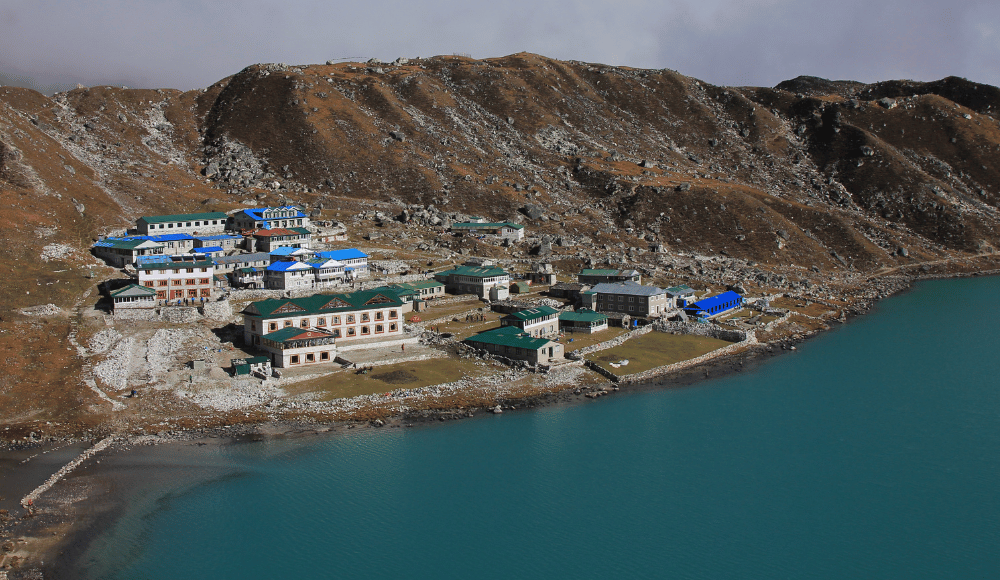
You can fly to the Gokyo valley directly from Kathmandu to Lukla. But to get to the top of Gokyo Ri, you need to hike some. Apart from this, you could join the drive packages, where you will drive from Kathmandu to Jiri, and join the trek onwards. For this, you need to have one additional permit which is the Gaurishankar conservation area permit. The two most ideal packages for the Gokyo Ri visit are described below. You can go through that to learn some more:
As already discussed, trekking to the Gokyo Ri is just incredible. In this trek, you will explore the new isolated side of the Nepal Himalayas. From the mountain views to the local's civilization, and the scenic lake to the diverse landscapes, this trek is full of vibrant shades you could ever find. So, this trek is superior among all, attracting a huge crowd every single year. Some of the available packages for the Gokyo Ri trek are listed below. Also, if you want, you can customise the packages on the basis of your preferences. Even you can extend the trek if you like to explore the Khumbu region more:
The best possible alternative to the Goyo Ri trekking is helicopter tours. In this helicopter ride, you will get the finest aerial views of the splendid Khumbu region. No matter which you choose, either the helicopter ride or the regular flight, you need to reach the Lukla first. Unlike the trekking, In this helicopter tour, you will not trek from Lukla, you will get here first, then again fly to the Gokyo valley. Here, there is a weight limit of 400 to 500 kg. So, no more than 4 individuals can take a tour on the same ride. For this Helicopter tour, the weather must be clear and visible, and then you will fly in the Khumbu region unobstructedly. Some of the packages for the Gokyo Ri Helicopter tours are listed below:
Gokyo Lakes Helicopter Tour from Kathmandu
Everest Base Camp and Gokyo Lakes Helicopter Tour from Kathmandu
Gokyo Lake Helicopter from Namche Bazaar
Before visiting any region, you need to know the region well so that you can take full advantage of your visit. Considering this, some of the travel tips for Gokyo Ri are listed below:
Always carry warm clothes no matter how hot the other regions are, as this region is always cold.
Pack some windshields as the strong breeze passes here.
Since the trails to Gokyo Ri from Gokyo village are steep uphill and slippery, you need to wear some comfortable hiking pairs.
Always carry a water bottle and drink a lot of water as there is a high chance of getting altitude sickness at such an elevation.
Gokyo Cho which lies just beside the Gokyo village is considered sacred, so don't perform any activity violating the religious beliefs.
Appreciate the locals and don't get into a fistfight with anyone.
Since you are in the mountainous region, don't inhale and pluck any mountain flowers as they can be toxic sometimes.
Except for the helicopter ride, always take a local guide while travelling in this region.
Related read: Nepal travel information
The initial trails to Gokyo Ri are fine and easy but from the Dole, the trail starts to get more complex, as you have to walk continuously for a longer period through the several ascends. Compared to the previous Dole trek, the trek from Machhermo is much easier. Also, the climb from Gokyo village up to the Gokyo Summit is much more strenuous than the overall trek. So, the trek to Gokyo Ri can be considered challenging yet the worthiest one.
Gokyo Ri, a pride of the Khumbu region lies on the western side of the Ngozumpa glacier, inside Sagarmatha national park, one of the national parks in the highest elevation. It is the viewpoint offering the best views of Mount Everest, Makalu, Cho Oyu, Lhotse, and the magnificent Gokyo valley and lakes.
Yes, it is. Though Everest looks much closer to Kalapathar, you will get a diverse panoramic view of the peaks including more than Everest. Four of the eight-thousanders Everest, Makalu, Lhotse, and Cho Oyu are visible from Gokyo Ri. Aiding the beauty is the Gokyo valley and the splendid Ngozumpa glacier.
Yes, you can get an unobstructed view of Everest from the Gokyo Ri. Not only Everest you can peek into several peaks such as Lobuche, Thamserku, Cho Oyu, Lhotse, Makalu, Gyachung Kang, and many others. It is also the vantage point offering the full picture of the sixth-highest peak in the world, Cho Oyu. Beneath Cho Oyu lies the largest glacier in the Himalayas, Ngozumpa glacier.
The altitude of the Gokyo Ri is 5357 m. People are often confused that Gokyo Ri is a Mountain. But, no, it is the best viewpoint in the Khumbu region, but not the mountain itself. The highest human settlement Gokyo valley lies below the Gokyo Ri at the elevation of 4750 m.
Three of the Gokyo lakes are visible during the Gokyo Ri trek. Among these there, the third Gokyo lake, which is also the major lake of the Gokyo system, Gokyo Cho (Dudh Pokhari) looks fabulous. On the lake shore, there lies the small hamlet, Gokyo village. If you want to explore all five Gokyo lakes you can simply join the Gokyo lakes trek via Gokyo Valley.
No, Gokyo Ri is not a mountain. It’s the vantage point vesting the spectacular view of the peaks, and the serine Khumbu region.
No, the Gokyo Ri trek and the Gokyo lakes trek are two different treks. Though these two treks share the same trails up to the Gokyo valley. From Gokyo valley, you will get multiple trail options, one leading to Renjo la pass, one to Gokyo Summit, one to the remaining Gokyo lakes, and another to the Everest base camp via Chola pass. If you are going for the Gokyo lakes trek you need to follow the trail leading to the fourth, fifth, and sixth Gokyo lakes which goes up until the Cho Oyu base camp.
The wonderful mountain vistas, Gokyo lakes, mountain valleys and settlements, locals’ lifestyle and tradition, and the distinctive flora and fauna of the Sagarmatha national park makes the trek to Gokyo Ri so exceptional.
Not so many faunas are spotted during the trek to Gokyo Ri. Commonly you will see Musk deer, Himalayan tahr, Yaks, Snowcocks, and Lophophorus on the trail. Also, the chance of spotting a Snow leopard during this trek is pretty slim.